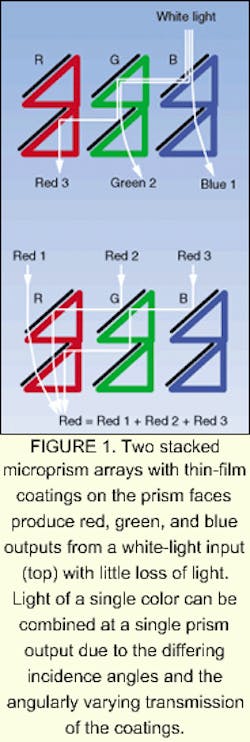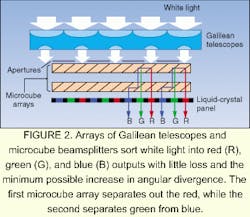LIQUID-CRYSTAL PROJECTORS: Micro-optics deliver bright colors
Researchers at National Chiao Tung University (Hsinchu, Taiwan) are developing novel micro-optical systems to boost the light output of single-panel liquid-crystal (LC) projection displays. Commercial single-panel LC projectors include arrays of pixel-sized absorptive or thin-film red, blue, and green filters that, in the process of creating color, unavoidably waste two-thirds of the available light. The researchers have taken the arrayed-optics concept a step further and built stacked panels of tiny thin-film filters, prisms, apertures, and lenses whose purpose it is to use both the transmitted and reflected light from the filters, resulting in almost-lossless color filtering.
In the first design, two one-dimensional arrays of long microprisms are stacked (see Fig. 1). The arrays each contain prisms with three different kinds of thin-film coatings. Although the light path of red, green, and blue color rays depends on which coating a white-light input ray strikes first, the result is that the red inputs from three adjacent prisms all exit through a single output prism, the green through another, and the blue through a third. Intermediate refraction by the prisms changes the angular direction of some of the beams, allowing, for example, more than one red light path to exit the same prism. The capability of combining beams of the same color exists because spectral transmission of the thin-film coatings varies with incidence angle. However, this combination method leads to a large increase in the output divergence angle, which also increases complexity of the subsequent projection lens.To reduce divergence angle, the researchers developed a second design containing stacked arrays of lenses, apertures, and microcube beamsplitters containing red and red-green transmitting filters (see Fig. 2). Two microlens arrays function as an array of tiny Galilean telescopes of 3X reduction; light exiting the telescopes passes through the microcube array. The 3X reduction allows light to be sorted by the microcube array without the necessity of refraction and the attendant large increase in divergence (there is still a smaller increase in angular divergence due to the telescopic reduction). While the lens-array fabrication is straightforward, the microcube arrays must be fabricated either by bonding many thin-film-coated rhomboidal elements to each other or by gluing two thin-film-coated microserrated sheets together.
Using a chromameter, a metal-halide light source, and a projection lens with f/2.8, the researchers measured the optical throughput and color purity of both types of devices. When compared to an array of planar thin-film color filters, both micro-optical devices showed a throughput increase of greater than a factor of two for all colors. Because color is based on the response of the human eye, improvements to the spectral bandpass shapes of the filters will raise the color optical throughput even further, say the researchers. Although color purity of the first micro-optical device was inferior, color purity of the second microlensed device was equal to that from planar thin-film filters.
The researchers have fabricated microprism arrays of 2-mm pitch by injection molding, with the master mold made by line electric-discharge cutting. Reducing the pitch to more-usable dimensions of 10-100 µm requires either electron-beam direct-write or gray-scale mask lithographic techniques, say the researchers, who are in the process of constructing such arrays.
About the Author
John Wallace
Senior Technical Editor (1998-2022)
John Wallace was with Laser Focus World for nearly 25 years, retiring in late June 2022. He obtained a bachelor's degree in mechanical engineering and physics at Rutgers University and a master's in optical engineering at the University of Rochester. Before becoming an editor, John worked as an engineer at RCA, Exxon, Eastman Kodak, and GCA Corporation.


